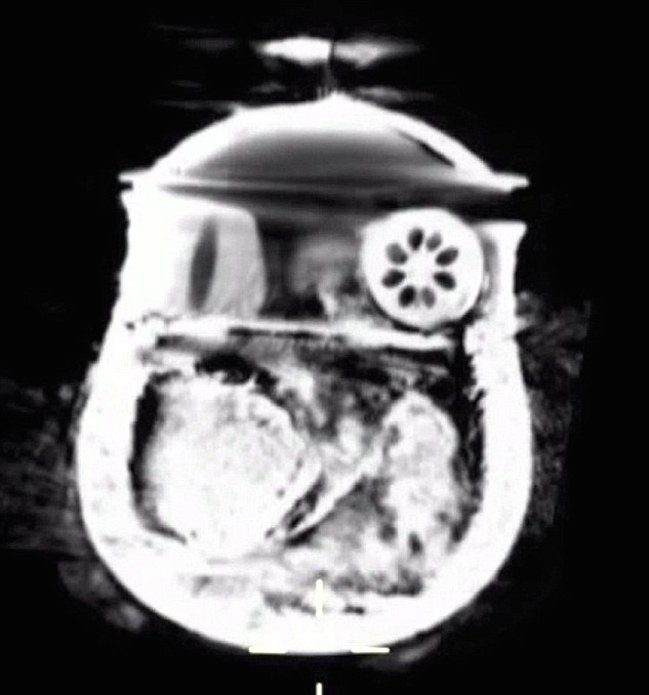GALLOWAY, SCOTLAND — In 2014 Derek McLennan, a retired businessman, was walking in Galloway, Scotland with his metal detector when he came across a literal treasure trove of Viking artifacts, the largest discovery of its kind in more than a century. More than 100 artifacts dating back to the year 900 were found, including crosses, Anglo-Saxon jewelry, pendants, silk from Byzantium and gaming pieces.
Above image: Photograph of CT scan courtesy of Deadline News.

The pot being prepped for its medical procedure. Photograph from Deadline News.
One of the most tantalizing pieces in the collection was a Carolingian pot, which was packed full of ancient goodies. Obviously, archeologists couldn’t just yank the lid off and dig in without damaging the works, so they first took it to a hospital for a CT scan. The scanner was able to show the researchers what was inside, even though the pot wasn’t opened until last month. Richard Welander, of Historic Environment Scotland, told the BBC:
“That exercise offered us a tantalising glimpse but didn’t prepare me for what was to come.
“These stunning objects provide us with an unparalleled insight to what was going on in the minds of the Vikings in Galloway all those years ago.
“They tell us about the sensibilities of the time, reveal displays of regal rivalries, and some of the objects even betray an underlying sense of humour, which the Vikings aren’t always renowned for!”
Stuart Campbell of the Treasure Trove Unit, said there was further research to be done on the items.
“The complexity of the material in the hoard raises more questions than it answers, and like all the best archaeology, this find doesn’t give any easy answers,” he said.
The mystery is tantalizing, moreso because the wealth of information inside the pot only leads to more puzzles. What was this pot doing there? The articles we saw didn’t mention anything about funeral practices, although the objects are likely heirlooms from a wealthy medieval family. The pieces look to be in excellent condition, giving researchers a healthy amount of evidence to study. The foreign silk is certainly an evocative piece. How did that end up in Scotland? There’s also a crucifix adorned with four symbols. There’s no consensus on what that symbolizes, but a guess could be that they stand for the four gospels. Taking everything together, it’s as though the pot is a time capsule with clues about ancient economics, politics, and spirituality. It’s fascinating stuff in a very handsome package.
What do you think of this (not quite) contemporary ceramic art? Let us know in the comments.

The vessel. Photograph from Live Leak.

An early cruciform adorned with odd markings. Photograph from SWNS.com.

A pendant found in the haul.

Wonderful coverage on this pot. Really amazing!
Amazing! Looking forward to more of its history.
So beautiful, just in its unearthed condition.
Love it! History in a jar instead of recovered jar fragments (shards). Wonder what glaze was used.